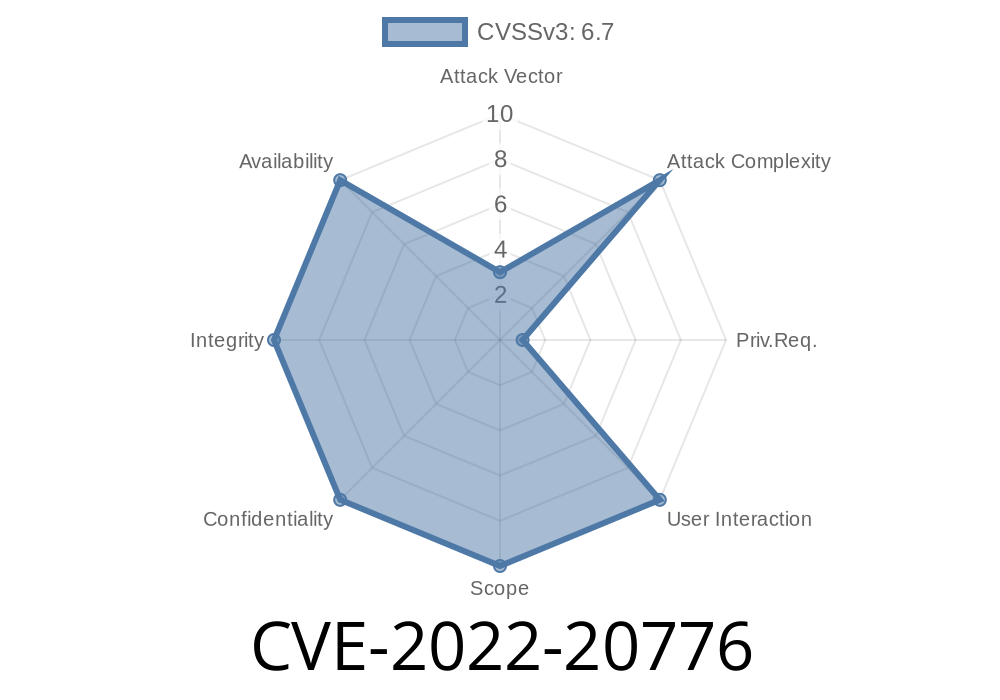Recently, several security vulnerabilities have been discovered in Cisco TelePresence Collaboration Endpoint (CE) Software and Cisco RoomOS Software, categorized under CVE-2022-20776. These vulnerabilities could potentially allow a malicious attacker to conduct path traversal attacks, view sensitive or confidential data, and write arbitrary files on a targeted device. This article will explore the details of these vulnerabilities, discuss the affected software, analyze the code snippet related to the vulnerability, and provide links to the original references for further investigation.
Three primary vulnerabilities have been identified in the affected software
1. Directory Traversal Vulnerability: This vulnerability could allow an attacker to access sensitive information on an affected device by sending a crafted HTTP request that contains directory traversal character sequences. The attacker could potentially view the contents of any accessible file on the system.
2. Arbitrary File Read Vulnerability: This vulnerability enables an attacker to read arbitrary files on the targeted device by sending a specifically crafted HTTP request. Sensitive data, like system configurations or personally identifiable information (PII), could be potentially exposed.
3. Arbitrary File Write Vulnerability: This vulnerability allows the attacker to create or overwrite files on an affected system by sending a maliciously crafted HTTP request. This attack could potentially result in unauthorized system changes or a complete compromise of the targeted system.
Affected Software
Cisco TelePresence Collaboration Endpoint (CE) Software and Cisco RoomOS Software are primarily affected by these vulnerabilities, for the following products:
* Cisco TelePresence SX Series
* Cisco TelePresence MX Series
* Cisco TelePresence EX Series
* Cisco TelePresence Integrator C Series
* Cisco Webex Room Series
* Cisco Webex Board Series
Code Snippet Analysis
The vulnerabilities can be triggered by sending malicious HTTP requests to specific endpoints, using directory traversal character sequences.
GET /..%2f..%2f..%2f..%2f..%2f..%2f..%2f..%2f..%2f..%2f..%2f../path/to/file HTTP/1.1
Host: vulnerabledevice.example.com
In this example, %2f corresponds to the / character URL-encoded, and by repeatedly using the sequence ..%2f, the attacker is attempting to move back up the file system hierarchy, potentially allowing them to access files outside the intended scope.
Exploit Details
To exploit these vulnerabilities, an attacker needs only network access to the targeted device and the ability to craft and send malicious HTTP requests. Once the attacker gains access to sensitive information or gains control over writing arbitrary files, they can potentially manipulate the system, compromise security, or exfiltrate confidential data.
Mitigation Steps
Cisco is releasing software updates to remediate these vulnerabilities, and it is highly recommended to apply them as soon as possible. In addition, administrators should implement network security best practices, monitor system logs for unusual activity, and appropriately restrict access to affected devices.
Original References
For more in-depth information about the CVE-2022-20776 vulnerabilities, please refer to the following Cisco Security Advisory:
* Cisco Advisory on Multiple Vulnerabilities in Cisco TelePresence Collaboration Endpoint (CE) Software and Cisco RoomOS Software
Conclusion
With the increasing importance of remote collaboration and communication, staying updated on security vulnerabilities and applying necessary fixes is crucial for ensuring the privacy and integrity of your systems. Don't hesitate to apply the latest software updates provided by Cisco and adopt good security practices to protect your devices from potential attackers.
Keep an eye on new information related to CVE-2022-20776 and other vulnerabilities, and prioritize the safety and security of your networks and devices. Stay safe, stay informed, and stay protected!
Timeline
Published on: 10/26/2022 15:15:00 UTC
Last modified on: 10/31/2022 15:39:00 UTC
